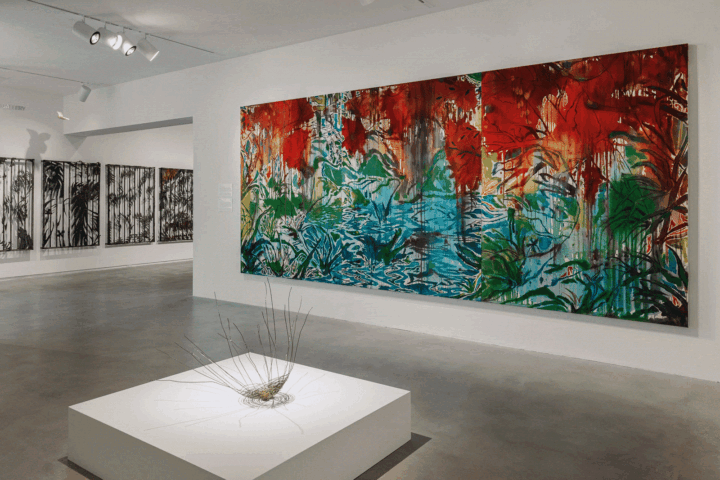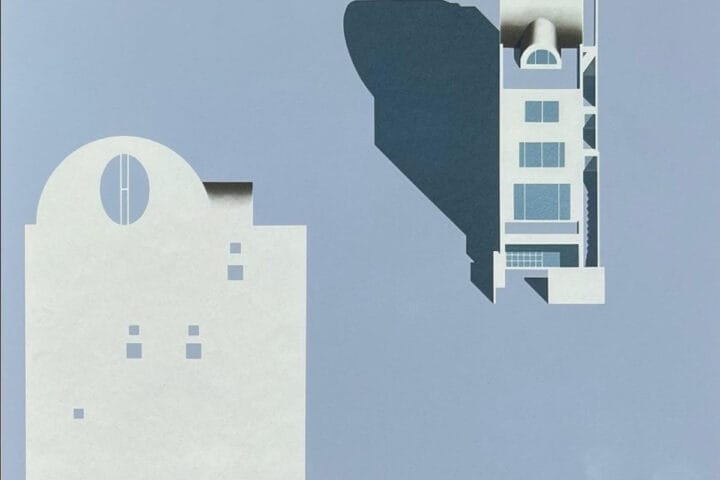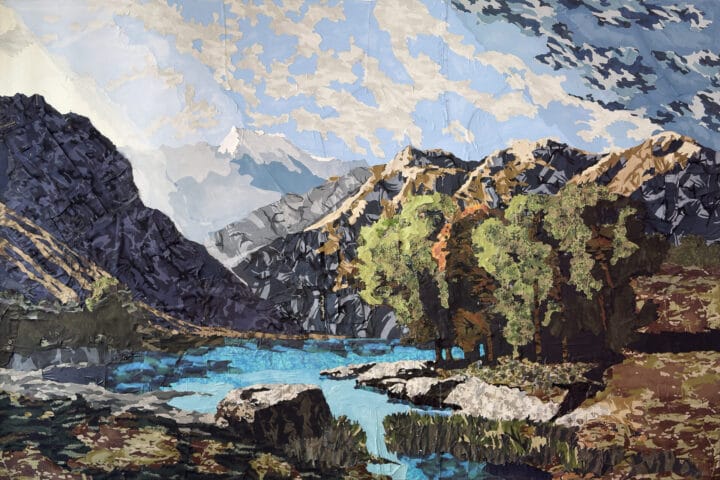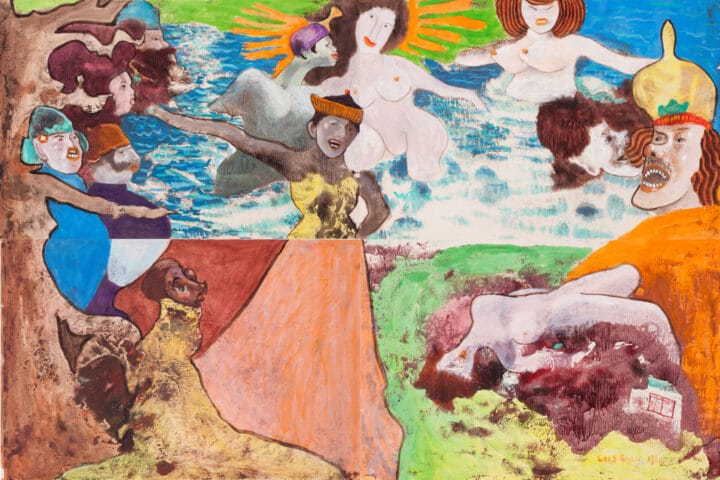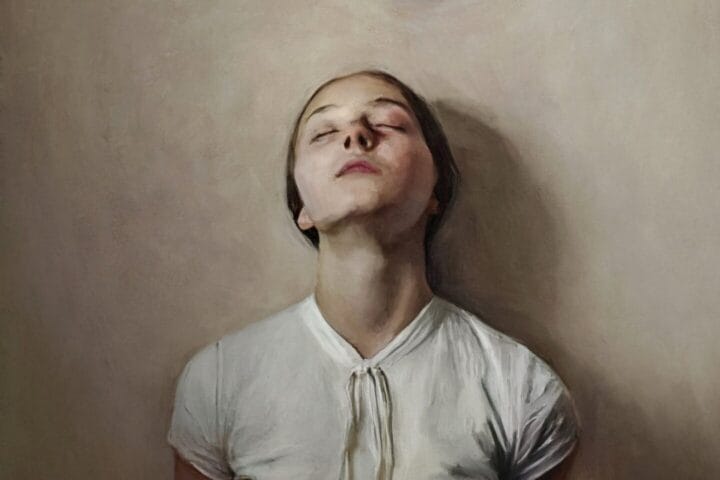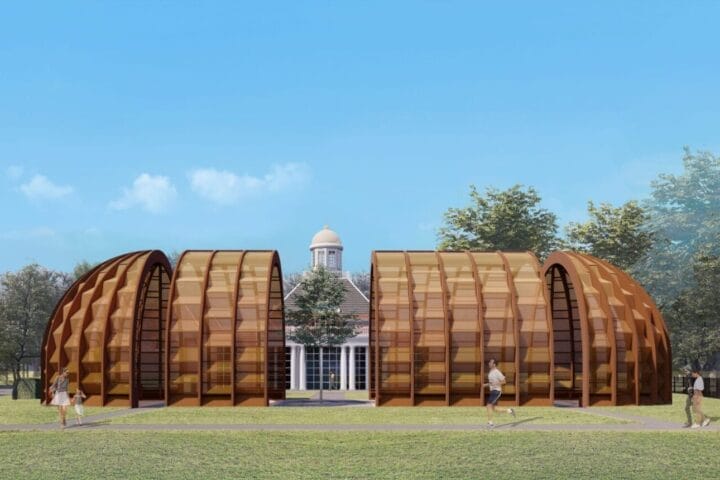David Maljkovic’s exhibition Overpaint with Shadows on the third floor of Sprüth Magers, London, presents a series of new paintings and architectural interventions that take the process of overpainting as both their subject and source. For Maljkovic, the act of overpainting is equally literal and metaphorical, pertaining not only to painting itself, but also addressing the content, or rather, the starting point.
Maljkovic is known for a multifaceted practice that, through a collagist approach referencing the works of other artists and his own earlier works and exhibitions, considers individual and collective attitudes toward the complexity of time, whilst also playing with the nature of the gaze. Through painting, he continues to address the themes he has also examined through photography, film, installation, sculpture, and collage.
Maljkovic is concerned with the tension between painting, object, and space to the extent that exhibition-making itself can be considered his subject. The galleries at Sprüth Magers come with their own inscribed narrative, a series of rooms with a domestic past. To this he has choreographed new ensembles, a series of painting events that present different positions of pictoriality, representing a certain idea about the painting and its action and meaning in a wider context. The materiality of the pictorial code itself is not always contained exclusively in the painting; it meanders within his practice, across various media, and through a broad field of references.
His use of pictorial montage recalls his earlier film work Images With Their Own Shadows (2008). Filmed at night, it consists of static compositions from the studio of the Croatian artist and architect Vjenceslav Richter. Taking over his title in which ‘painting’ becomes ‘image’, spatial paintings in their transfer to 16 mm tape become film images. In this process, they confirm the place of the ‘shadows’ in the retelling of history.
With a key element of his work the careful choreography of the exhibition experience, there is a sublimation of his driving themes into this singular focal point, his main drives made manifest as the exhibition itself. Its scenography, as well as the origins of the motifs often linked to the history and experiences of stage design, unfold within the scenic quality of the paintings. Throughout, loose architectural details of stage sets invite the viewer to gaze into them, perhaps as if they were in the theatre audience, with perspectival illusions of proscenium arches, or of props and players scattered across the stage.
Take, for example, Overpaint with Shadows (2023) derived from 1923 stage designs by Croatian artist Ljubo Babić for the play ‘Shadows’, an immaterial design for a ballet performance that is materialised solely through light and shadow. Building upon the sketch of the scenography, Maljkovic overpaints the previous painting so that the shadow itself becomes ambiguous. Paint across the canvas appears at points scumbled or as a thin stain, and elsewhere more heavily overpainted, previous tones evident underneath.
This principle is taken from his previous cycle of paintings Overpaint with Venice (2023). Here, too, the source is Babić and a drawing for a stage design he produced in 1918 for an unperformed rendition of Verdi’s opera Otello. In this process, the motifs become elements for overpainting, taking them beyond their given role. In the series of paintings It may have been overpainted even before it was put on the exhibition, the act of overpainting behaves differently from painting to painting. In some areas, the manipulated pattern emphasizes the structure of the painting, and elsewhere, it is present as a vector drawing used to direct a laser engraving that travels over its frame.
The painting Two Models (2022) includes two random elements that form a new pictorial relationship—a costume from Anatol Petrytsky’s ballet The Red Poppy and Ljubo Babić’s stage design for the play Spring Awakening. Here, two different motifs from the 1920s, derived from two sources, appear restless and are treated as still lives. Equally, in two works titled The Missing Master (2023 and 2024), the role of costumes by Petrytsky create an archetype or model of the master.
Throughout, the various sources and elements are used to build a new whole, the process itself transcending their given content and removing their meaning.
Regardless of the narrative present at the starting point of each painting, its execution does not directly mediate that narrative but rather opens new semantic processes. Maljkovic’s series of motifs act as metaphorical platforms on which they are objectified, becoming signs whose content, as well as their mutual relations, are positioned and moderated precisely by the painting process. Motifs become characters, and their roles change in the construction of painting itself. In these new works, Maljkovic continues to work through an introspective instinct and by not fixing his own work in a permanent state, he (re)creates new solutions to work against, if not quite overcome, these impersonal forces.
David Maljkovic (*1973, Rijeka) lives and works in Zagreb. Selected solo exhibitions include Quetzal Art Center, Portugal (2023), Museum of Modern and Contemporary Art, Rijeka (2020), Renaissance Society, Chicago (2019), Museum of Modern Art, Ljubljana, VOX Centre de l’Image Contemporaine, Montreal (both 2016), Palais de Tokyo, Paris (2014), Kunstmuseum St. Gallen (2014), Baltic Center for Contemporary Art, Gateshead (2013), CAC-Contemporary Art Senter, Vilnius (2013), Kunsthalle Basel (with Latifa Echakhch, 2012), Sculpture Center, New York (with Lucy Skaer, 2012), Secession, Vienna (2011–2012), Museo Nacional Centro de Arte Reina Sofía, Madrid (2009), Kunstverein Hamburg (2007) and P.S.1 Contemporary Art Center, New York (2007). Selected group exhibitions include Museum of Modern Art, Ljubljana, Fondazione Merz, MoMA, New York (all 2019), Museum of Contemporary Art, Zagreb, ICA, Boston (both 2018), Mumok, Vienna (2016), Walker Art Centre, Minneapolis (2015), Museo Tamayo, Mexico City (2014), MAXXI Museum, Rome (2013), La Triennale, Paris (2012), Bucharest Biennale 5 (2012), Gallery of Modern Art, Glasgow (2011–2012), Arnolfini, Bristol (2011), Centre Pompidou, Paris (2011), Museo de Arte Contemporáneo de Castilla y León (2011) and the 29th Bienal de São Paulo (2010). He was included in the 56th Venice Biennale (2015).

